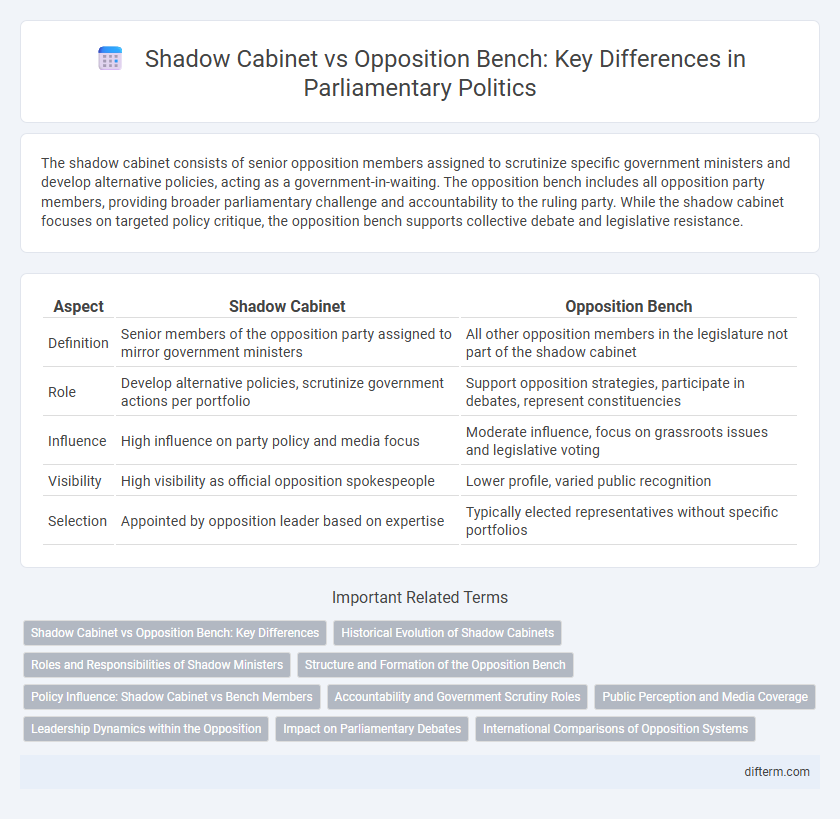The shadow cabinet consists of senior opposition members assigned to scrutinize specific government ministers and develop alternative policies, acting as a government-in-waiting. The opposition bench includes all opposition party members, providing broader parliamentary challenge and accountability to the ruling party. While the shadow cabinet focuses on targeted policy critique, the opposition bench supports collective debate and legislative resistance.
Table of Comparison
| Aspect | Shadow Cabinet | Opposition Bench |
|---|---|---|
| Definition | Senior members of the opposition party assigned to mirror government ministers | All other opposition members in the legislature not part of the shadow cabinet |
| Role | Develop alternative policies, scrutinize government actions per portfolio | Support opposition strategies, participate in debates, represent constituencies |
| Influence | High influence on party policy and media focus | Moderate influence, focus on grassroots issues and legislative voting |
| Visibility | High visibility as official opposition spokespeople | Lower profile, varied public recognition |
| Selection | Appointed by opposition leader based on expertise | Typically elected representatives without specific portfolios |
Shadow Cabinet vs Opposition Bench: Key Differences
The Shadow Cabinet is composed of senior members of the main opposition party assigned to scrutinize and challenge specific government ministers, providing alternative policies and holding the government accountable. The Opposition Bench includes all other opposition members who do not hold official Shadow Cabinet positions but still contribute to debates and parliamentary activities. The key difference lies in the Shadow Cabinet's formal roles mirroring the government's Cabinet, while the Opposition Bench lacks this structured portfolio responsibility.
Historical Evolution of Shadow Cabinets
The shadow cabinet emerged in the 19th century United Kingdom as a formalized group of opposition spokespeople mirroring the official cabinet to hold the government accountable. Its evolution reflects efforts to institutionalize parliamentary scrutiny and prepare opposition parties for potential governance by designating specific policy areas to shadow ministers. This concept spread globally, influencing parliamentary democracies by structuring opposition benches with distinct portfolios aligned with government departments.
Roles and Responsibilities of Shadow Ministers
Shadow Ministers play a critical role in holding the government accountable by scrutinizing policies and proposing alternatives within their assigned portfolios. They monitor government actions, question ministers, and engage in debates to ensure transparency and effective governance. Unlike the broader opposition bench, which includes all opposition members, shadow ministers have specific responsibilities mirroring those of official ministers to provide focused oversight and policy development.
Structure and Formation of the Opposition Bench
The opposition bench in parliamentary systems consists of all parties not in government, including the official opposition and smaller opposition groups, structured to hold the government accountable through debate and scrutiny. The shadow cabinet, a select group within the official opposition, is formed to mirror each government minister's portfolio, providing policy alternatives and coordinated critique. This structure allows the opposition bench to organize effectively, ensuring a cohesive challenge to government legislation and contributing to democratic checks and balances.
Policy Influence: Shadow Cabinet vs Bench Members
Shadow cabinet members hold designated portfolios and develop detailed alternative policies, directly shaping their party's stance and influencing public discourse. Opposition bench members, lacking formal roles, contribute through debate, questioning, and grassroots engagement but have limited direct input in policy formulation. The structured responsibility of shadow cabinet members enables a more strategic and cohesive policy influence compared to the broader opposition bench.
Accountability and Government Scrutiny Roles
The shadow cabinet plays a critical role in holding the government accountable by scrutinizing policies, proposing alternatives, and challenging decisions within their specific portfolios. Opposition bench members support this function by actively questioning government actions during debates, committees, and parliamentary sessions, ensuring transparency and responsiveness. Together, these entities enhance democratic oversight, fostering government accountability through rigorous examination and public discourse.
Public Perception and Media Coverage
Public perception often views the shadow cabinet as a more organized and credible alternative to the government, enhancing its media coverage compared to the broader opposition bench. Media outlets tend to focus on shadow cabinet members due to their defined portfolios and spokesperson roles, resulting in higher visibility and influence in political discourse. This targeted coverage boosts the shadow cabinet's reputation as a government-in-waiting, while the opposition bench may be perceived as less cohesive or effective.
Leadership Dynamics within the Opposition
The shadow cabinet functions as a structured leadership team within the opposition bench, tasked with scrutinizing government policies and proposing alternatives. Members of the shadow cabinet hold specific portfolios mirroring government ministers, enhancing their credibility and readiness to assume office. This leadership dynamic fosters strategic coordination and unified messaging, strengthening the opposition's ability to influence public discourse and hold the ruling party accountable.
Impact on Parliamentary Debates
The shadow cabinet significantly shapes parliamentary debates by providing organized and focused critiques of government policies, enhancing accountability and policy scrutiny. Members of the opposition bench contribute diverse perspectives, fostering a dynamic and comprehensive discourse on legislative matters. This structured opposition ensures robust debate, deepening democratic processes and influencing public opinion.
International Comparisons of Opposition Systems
Shadow cabinets function as parallel executive teams in parliamentary democracies, systematically scrutinizing government policies and proposing alternatives. Compared to opposition benches, they offer structured policy oversight and clearer accountability, as seen in countries like the United Kingdom, Canada, and Australia. Internationally, opposition systems vary, with some nations emphasizing formalized shadow cabinets while others rely on less institutionalized opposition benches to ensure democratic checks and balances.
shadow cabinet vs opposition bench Infographic

 difterm.com
difterm.com